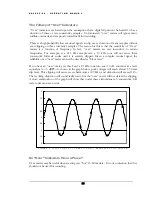
A D 2 4 0 2 - 9 6 - O P E R A T I N G M A N U A L
Note: The AD2402-96 automatically mutes for the first 10 seconds after applying
power. While muted, the “Lock” LED will flash nine times indicating that
automatic calibration is in progress. This is not an indication of a lock error.
“Word Length Mode” Switch
The “Word Length Mode” switch is a twelve-position rotary switch. It
selects 24, 20, or 16-bit
word lengths at the main outputs
. All 16 and 20-bit Word Length Reduction (WLR) modes are
TPDF dithered prior to word length reduction.
There are seven word length reduction modes (“TPDF”, “NN1”, “NN2”, and “NN3”, “NS1”,
“NS2”, and “NS3”). All forms of word length reduction raise the noise floor of a digital
transmission system. TPDF dither is spectrally flat, it is not shaped, and will sound noisier than
any of the “NN” or “NS” modes. “NS1”, “NS2”, and “NS3” are noise-shaping modes which are
psycho-acoustically optimized to take advantage of the ear’s low-level sensitivity curve. “NS1”,
“NS2”, and “NS3” will sound 6, 12, and 18 dB quieter than “TPDF” respectively. “NS1”,
“NS2”, and “NS3” can provide 17-bit, 18-bit, and 19-bit performance respectively at a 16-bit
word length. At 20-bits, “NS1” and “NS2” provide 21-bit and 22-bit performance respectively.
For the best performance, use the maximum word length that is compatible with your digital
audio equipment. Maintain 24 or 20-bit word lengths as long as possible. If WLR to 16-bits
is required, do so at the latest possible point and time. Avoid processing 16-bit signals. In
general, NS2 will produce the quietest 20-bit signal, and NS3 will produce the quietest 16-bit
signal.
Caution: Do not apply word length reduction when using the D-to-D function for
dubbing 16-bit tapes.
Use the “24” setting for all D-to-D functions unless you
wish to simultaneously reduce the word length of the input digital audio signal. Use
the “24” setting for 16-bit to 16-bit dubbing, 20-bit to 20-bit dubbing, and 24-bit to
24-bit dubbing. For more information see
Table 1
.
“Sample Rate” Switch
The “Sample Rate” Switch is a twelve-position rotary switch. This switch selects the sample clock
frequency, the PLL (Phase Locked Loop) mode, dual or single cable interface modes, and digital-
to-digital functions.
For typical A/D conversion applications, select either “44.1” or “48”.
If an external digital
audio reference is connected to the “Digital Input”, the AD2402-96 will automatically switch from
internal to external clock, and the “Lock” LED will turn on. A feature unique to Benchmark
13














































